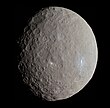|
(524435) 2002 CY248
(524435) 2002 CY248 (provisional designation 2002 CY248) is a trans-Neptunian object and weak dwarf-planet candidate from the classical Kuiper belt in the outermost region of the Solar System, approximately 400–450 kilometers (250–280 mi) in diameter. It was first observed on 6 February 2002, by American astronomer Marc Buie at the Kitt Peak National Observatory in Arizona, United States.[1] Orbit and classification2002 CY248 orbits the Sun at a distance of 39.4–53.1 AU once every 314 years and 6 months (114,859 days; semi-major axis of 46.2 AU). Its orbit has an eccentricity of 0.15 and an inclination of 7° with respect to the ecliptic.[3] The body's observation arc begins at Kitt Peak with its official first observation on 6 February 2002.[1] A 10-million-year integration of the orbit shows that it is a Classical Kuiper belt object that does not get closer to the Sun than 38.8 AU (5.80 billion km) or further than 54 AU.[4] Physical characteristicsBased on an absolute magnitude of 5.2,[3] and an assumed albedo of 0.09, the Johnston's archive estimates a mean diameter of approximately 404 kilometers (251 mi),[5] while astronomer Michael Brown assumes an albedo of 0.06 and calculates a diameter of 449 kilometers (279 mi) using a fainter magnitude of 5.5. Brown also characterizes the object as a "probable dwarf planet", an intermediate category in his classification scheme (also see list of candidates).[6] As of 2018, no rotational lightcurve of this object has been obtained from photometric observations. The object's rotation period, pole and shape remain unknown.[3] Numbering and namingThis minor planet was numbered by the Minor Planet Center on 18 May 2019 (M.P.C. 114619). As of 2019, it has not been named.[7] See alsoReferences
External links
|
||||||||||||||||||||||||||||||||||||||||||||||||||||||

